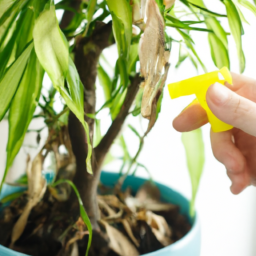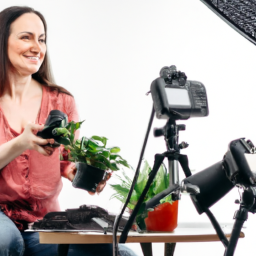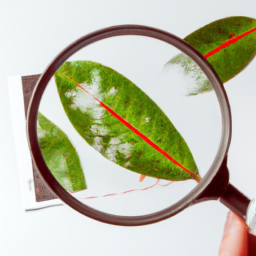
Have you ever noticed your indoor plants looking a little under the weather? Perhaps the leaves are turning yellow, or they’re drooping more than usual. If you’re a plant parent, you know how frustrating it can be to see your beloved green friends struggling. But fear not! In this blog post, we will provide you with a troubleshooting guide for common indoor plant symptoms: a quick reference to help you diagnose and treat any issues your plants may be facing. Whether you’re a seasoned plant enthusiast or just starting out, this guide will be your go-to resource for keeping your indoor plants healthy and thriving. So, let’s dive in and discover the secrets to maintaining a flourishing indoor garden!
Identifying and Resolving Nutrient Deficiencies in Indoor Plants
Indoor plants are a great way to bring nature into your home or office space. They not only add beauty and freshness to the environment but also provide numerous health benefits. However, just like any living organism, plants require essential nutrients to thrive and stay healthy. When these nutrients are lacking, plants may exhibit various symptoms of deficiency. In this troubleshooting guide, we will help you identify and resolve nutrient deficiencies in your indoor plants, ensuring they receive the care they need to flourish.
Understanding the Importance of Nutrients
Before we delve into the specific nutrient deficiencies, it’s crucial to understand the significance of nutrients for indoor plants. Nutrients are essential elements that plants need in varying amounts to carry out their vital functions. There are three primary macronutrients that plants require in large quantities: nitrogen (N), phosphorus (P), and potassium (K). These macronutrients play a crucial role in plant growth, development, and overall health.
In addition to macronutrients, plants also need secondary nutrients such as calcium (Ca), magnesium (Mg), and sulfur (S), as well as micronutrients like iron (Fe), manganese (Mn), zinc (Zn), and others. These nutrients are equally important, although plants need them in smaller quantities.
Now that we understand the importance of nutrients let’s move on to identifying and resolving specific nutrient deficiencies in indoor plants.
1. Nitrogen Deficiency
Nitrogen is a vital nutrient required for the production of chlorophyll, which is responsible for the green color in plants. A nitrogen deficiency often manifests as pale or yellowing leaves, stunted growth, and overall poor plant vigor. To resolve this deficiency, you can apply a nitrogen-rich fertilizer to the soil or use organic alternatives like compost or worm castings. Remember to follow the instructions on the fertilizer package to avoid over-fertilization, which can harm the plant.
Moreover, ensure that your indoor plants receive adequate sunlight, as nitrogen deficiency can also be a result of insufficient light. If possible, move the plant to a brighter location or consider using artificial grow lights.
2. Phosphorus Deficiency
Phosphorus is essential for energy transfer and root development in plants. A phosphorus deficiency often leads to slow or stunted growth, darkening or purpling of leaves, and weak stems. To address this deficiency, you can apply a phosphorus-rich fertilizer specifically formulated for indoor plants. Additionally, maintaining proper soil pH levels between 6 and 7 can enhance phosphorus availability to the plant roots.
It’s important to note that excessive phosphorus can inhibit the uptake of other nutrients, so it’s crucial to follow the recommended dosage provided by the fertilizer manufacturer.
3. Potassium Deficiency
Potassium plays a vital role in overall plant health, regulating water uptake, photosynthesis, and disease resistance. Symptoms of potassium deficiency include yellowing or browning leaf edges, weak stems, and reduced fruit or flower production. To treat this deficiency, you can apply a potassium-rich fertilizer or use organic options like wood ash or banana peels, which are natural sources of potassium.
Ensure that your indoor plants receive adequate watering, as potassium deficiency can also be exacerbated by drought conditions. However, be cautious not to overwater, as excessive moisture can lead to other issues like root rot.
Conclusion
Identifying and resolving nutrient deficiencies in indoor plants is essential to ensure their optimal health and growth. By understanding the importance of nutrients and recognizing the symptoms of deficiencies, you can take appropriate measures to address them. Remember to provide a balanced diet of macronutrients, secondary nutrients, and micronutrients, while also considering other factors like light, water, and soil pH. With proper care and attention, your indoor plants will thrive and bring joy to your space for years to come.

Troubleshooting Guide for Common Indoor Plant Symptoms: A Quick Reference
2. Dealing with Common Pests and Diseases in Indoor Plants
Indoor plants are a great way to bring nature into our homes and offices. They provide a sense of tranquility and beauty, but sometimes they can also face challenges in the form of pests and diseases. In this section, we will explore some common pests and diseases that indoor plants may encounter and discuss effective ways to deal with them.
Pests
Pests can be a major annoyance for indoor plants. They can damage the leaves, stems, and roots of your plants, leading to stunted growth and even death if left untreated. Here are some common pests you may come across:
1. Aphids: These tiny insects are usually found on the undersides of leaves. They suck the sap from the plants, causing leaves to curl and turn yellow. To get rid of aphids, you can spray a mixture of water and dish soap on the affected areas.
2. Spider Mites: Spider mites are very small pests that can create fine webbing on the leaves of your plants. They feed on the plant’s sap, leading to yellow or brown spots. To eliminate spider mites, you can use a mixture of water and neem oil and spray it on the affected plants.
3. Mealybugs: Mealybugs are white, cotton-like insects that usually gather in clusters on the stems and leaves of plants. They suck the sap from the plants, causing them to weaken and become discolored. To remove mealybugs, you can use a cotton swab dipped in alcohol to wipe them off the plant.
4. Fungus Gnats: Fungus gnats are small flies that are attracted to moist soil. Their larvae feed on the roots of plants, leading to poor growth and root rot. To control fungus gnats, you can let the soil dry out between waterings and use yellow sticky traps to catch the adult flies.
Diseases
Indoor plants can also be susceptible to various diseases, which can weaken and eventually kill them if not properly addressed. Here are some common diseases you may encounter:
1. Powdery Mildew: Powdery mildew appears as a white, powdery substance on the leaves and stems of plants. It can hinder photosynthesis and stunt growth. To treat powdery mildew, you can spray a mixture of water and baking soda on the affected areas.
2. Root Rot: Root rot is caused by overwatering or poorly draining soil, which leads to the roots becoming waterlogged and susceptible to fungal infections. To prevent root rot, make sure your plants are potted in well-draining soil and avoid overwatering.
3. Leaf Spot: Leaf spot is characterized by dark, irregular spots on the leaves. It is caused by fungal or bacterial infections. To control leaf spot, remove and destroy the affected leaves and ensure good air circulation around the plant.
Remember, prevention is always better than cure when it comes to pests and diseases. Regularly inspect your indoor plants for any signs of infestation or disease, and take appropriate action as soon as possible. By providing your plants with the right care, including proper watering, adequate sunlight, and a clean environment, you can help them thrive and minimize the risk of pests and diseases.
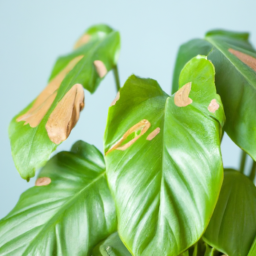
Understanding and Addressing Environmental Factors Affecting Indoor Plant Health
Indoor plants can bring life and beauty to any space, but sometimes they can suffer from various symptoms that indicate underlying issues. It is important to understand and address the environmental factors that can affect the health of your indoor plants. In this guide, we will discuss common indoor plant symptoms and provide you with a step-by-step troubleshooting process to help you identify and rectify the problems.
1. Insufficient Light
One of the most common issues indoor plants face is insufficient light. Plants need light for photosynthesis, the process that allows them to convert light energy into chemical energy to fuel their growth. Without adequate light, plants may exhibit several symptoms:
Yellowing Leaves: If your indoor plant’s leaves are turning yellow, it could be a sign of insufficient light. The chlorophyll in the leaves breaks down, causing the yellow coloration.
Leggy Growth: If your plant is reaching towards the light source and has long, stretched-out stems, it is a clear indication that it is not receiving enough light. This leggy growth is an attempt by the plant to maximize light absorption.
Slow or Stunted Growth: Insufficient light can also lead to slow or stunted growth. If your plant is not growing as expected or is not producing new leaves, it may be due to a lack of light.
To address insufficient light, consider the following steps:
1. Assess the Lighting Conditions: Evaluate the amount of natural light your indoor plant receives. Observe the intensity and duration of sunlight in the specific location where the plant is situated.
2. Adjust the Placement: If you notice your plant is not receiving enough light, consider moving it to a brighter location. Place it near a window with bright, indirect light, or consider using artificial grow lights to supplement the natural light.
3. Monitor and Observe: After adjusting the lighting conditions, closely monitor your plant’s response. If the symptoms persist or worsen, you may need to reassess the lighting requirements of your specific plant species.
2. Improper Watering
Watering is another critical factor in maintaining the health of your indoor plants. Both overwatering and underwatering can lead to various symptoms that indicate water-related issues:
Yellowing or Browning Leaves: Overwatering can cause the roots to become waterlogged, leading to root rot. This can result in yellowing or browning leaves as the roots are unable to absorb nutrients properly.
Drooping or Wilting: Underwatering, on the other hand, can cause the plant to lose turgidity, resulting in drooping or wilting leaves. The lack of water restricts the plant’s ability to maintain its structure and support its growth.
Root Rot: Overwatering can create a favorable environment for fungal and bacterial growth, leading to root rot. If you notice a foul smell or mushy roots when you remove the plant from its pot, it is a clear indication of root rot.
To address watering issues, follow these steps:
1. Check the Moisture Level: Before watering your plant, check the moisture level of the soil. Stick your finger about an inch deep into the soil. If it feels dry, it’s time to water. If it feels moist, wait for a few more days before watering again.
2. Water Properly: When watering, ensure that you provide enough water to thoroughly moisten the soil. Allow excess water to drain out from the bottom of the pot to prevent waterlogging.
3. Establish a Watering Schedule: Create a watering schedule based on the specific needs of your plant species. Some plants prefer to dry out slightly between waterings, while others prefer consistently moist soil. Research the watering requirements of your indoor plants to establish an appropriate schedule.
3. Inadequate Humidity
Indoor environments often have lower humidity levels than what some plants naturally thrive in. Low humidity can cause several symptoms in indoor plants:
Brown Leaf Tips or Edges: When the air is dry, plants lose moisture through their leaves, which can lead to brown tips or edges. This is especially common in plants with high humidity requirements.
Leaf Curling or Crinkling: Inadequate humidity can cause leaves to curl or crinkle. This is the plant’s way of reducing the surface area exposed to dry air, minimizing moisture loss.
Stunted Growth: Plants that require higher humidity may exhibit stunted growth if the air is too dry. The lack of moisture can hinder their ability to absorb nutrients and grow properly.
To address inadequate humidity, consider the following steps:
1. Group Plants Together: Grouping plants together can create a microclimate with higher humidity levels. As plants transpire, they release moisture into the surrounding air, increasing humidity.
2. Use a Humidifier: If the air in your home is consistently dry, consider using a humidifier to increase humidity levels. Place it near your indoor plants to provide them with the moisture they need.
3. Mist the Leaves: Regularly misting the leaves of your plants can help increase humidity levels temporarily. Use a spray bottle filled with room temperature water and mist the leaves, taking care not to soak the soil.
By understanding and addressing the environmental factors affecting indoor plant health, you can ensure that your plants thrive and flourish. Remember to regularly observe and monitor your plants for any signs of distress, and take appropriate action promptly. With proper care and attention, your indoor plants will bring beauty and vitality to your space for years to come.
Here’s what we learned
Indoor plants are a great way to bring life and greenery into our homes, but sometimes they can start showing signs of distress. Whether it’s droopy leaves, yellowing foliage, or wilting stems, it’s important to address these symptoms promptly to ensure our beloved plants stay healthy and vibrant. In this blog post, we will provide you with a quick troubleshooting guide for common indoor plant symptoms, so you can easily identify the issue and take appropriate action.
One common problem many indoor plant owners face is overwatering. If you notice your plant’s leaves turning yellow and feeling mushy, it’s a clear sign that you’re giving it too much water. To fix this, allow the soil to dry out completely before watering again, and make sure your pot has proper drainage. On the other hand, if your plant’s leaves are dry and crispy, it’s a sign of underwatering. Increase the frequency of your watering, but be cautious not to overdo it.
Another common issue is inadequate lighting. If your plant’s leaves are pale or stretching towards the light source, it’s an indication that it’s not receiving enough light. Move your plant to a brighter spot, preferably near a window with indirect sunlight. However, if your plant’s leaves are turning brown or scorched, it might be getting too much direct sunlight. In this case, move it to a more shaded area or use curtains to filter the light. By troubleshooting these common symptoms, you can ensure your indoor plants thrive and continue to bring beauty to your living space.
Let me leave you with some FAQs:
Q1: Why are the leaves of my indoor plant turning yellow?
A1: Yellow leaves on indoor plants can be caused by a variety of factors. The most common reasons include overwatering, underwatering, lack of sunlight, or nutrient deficiencies. To troubleshoot this issue, check the moisture level of the soil, make sure your plant is receiving adequate sunlight, and consider fertilizing if necessary.
Q2: How do I know if my indoor plant is being overwatered?
A2: Overwatering is a common problem that can lead to root rot and other issues. Signs of overwatering include wilting leaves, yellowing leaves, or a musty smell coming from the soil. To address this, allow the soil to dry out between waterings and ensure proper drainage by using well-draining pots.
Q3: What can I do if my indoor plant is not growing well?
A3: If your indoor plant seems to be struggling with growth, a few factors may be at play. First, ensure that your plant is receiving enough light. Consider moving it closer to a window or providing supplemental artificial light. Additionally, check the soil moisture and adjust watering accordingly. Finally, make sure your plant is receiving the right amount of nutrients by fertilizing it appropriately.
Q4: How can I prevent pests from infesting my indoor plants?
A4: Preventing pests in indoor plants is crucial for their health. To keep pests at bay, regularly inspect your plants for any signs of infestation, such as sticky residue, webs, or holes in leaves. If you notice pests, isolate the affected plant and treat it with appropriate insecticides or natural remedies like neem oil. Additionally, maintain good plant hygiene by removing dead leaves and regularly cleaning the plant’s surroundings.
Q5: What should I do if my indoor plant’s leaves are wilting?
A5: Wilting leaves can be a sign of underwatering, overwatering, or insufficient humidity. To address this issue, check the moisture level of the soil and adjust your watering routine accordingly. If the soil is consistently moist, reduce watering frequency. If the air in your home is dry, consider placing a humidifier near your plant or misting its leaves regularly. Proper watering and humidity levels should help revive your plant’s wilted leaves.
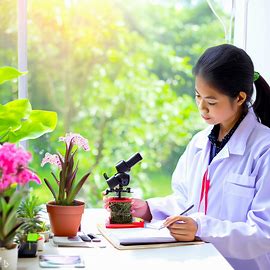
Lisa Chen is a seasoned indoor gardening expert and the author of several bestselling books on the topic. With a background in horticulture and urban farming, Lisa is dedicated to helping urban dwellers embrace the joys of cultivating green spaces indoors. Her detailed guides and hands-on tips empower readers to transform their living spaces into thriving plant sanctuaries.

